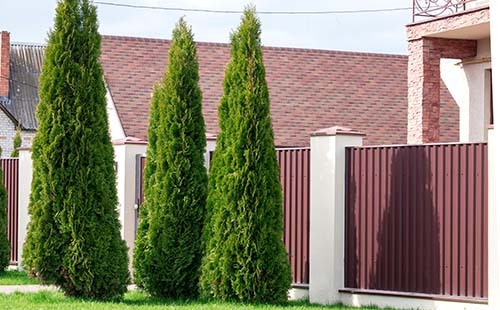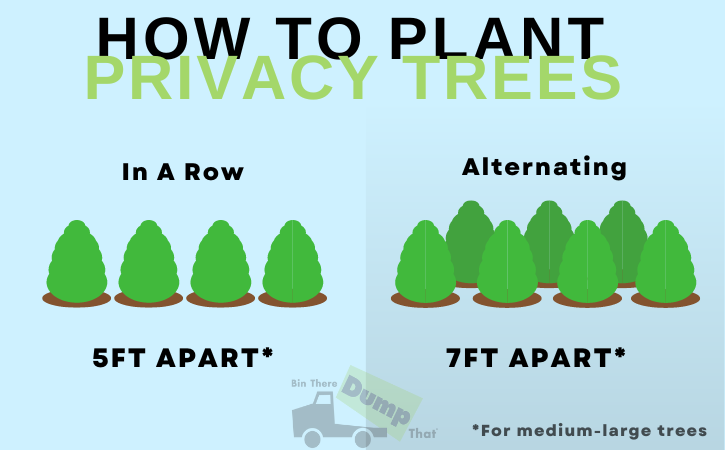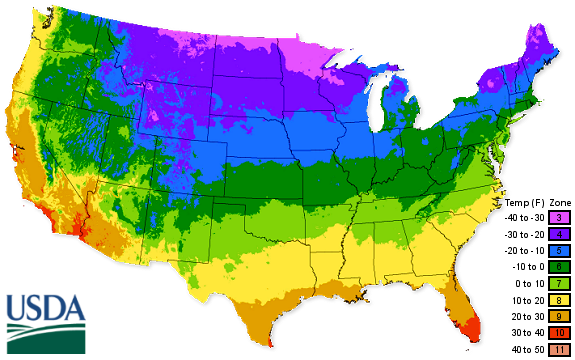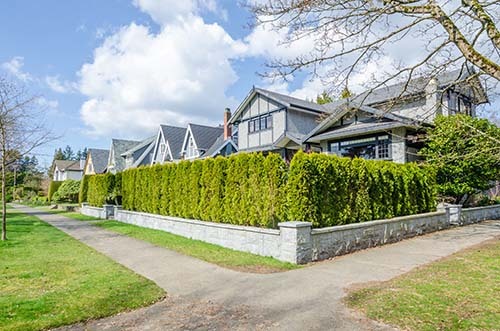
Privacy trees can transform your backyard into the private oasis you’ve always wanted. Whether you love your neighbors or not, we all want a space where we can sit with family and friends without prying eyes watching our every move. One of the best ways to achieve this is with border trees that not only give you that privacy but also add a touch of style to your yard as well. Read on for our thoughts on the best trees for yard privacy and other great alternatives as well.
The problem with using privacy trees is that it takes time for them to grow and provide you with the solitude you’re looking for. There are some trees that grow faster than others though, so it’s just a matter of choosing the right ones for the job. How do you know which privacy trees are fast-growing and which ones take a long time to reach the heights you need? We’ve done that research for you.

As it happens there are a number of trees that are fast-growing and ideal as privacy trees. Here are our main recommendations for the best barrier trees:
When planting trees for privacy, there are two methods you can choose from to get the most of your space. The first option is to plant the trees in a single row. If you're planting a tree sapling, you'll need to account for how large they will get when they are fully grown. For medium to larger trees, like Emerald Green, Thuja Green Giant or Leyland Cypress, you'll need to account for roughly 5 feet of space between each sapling
The second option is two alternate the trees diagnoally. Alternating the trees mean you'll need to have a space of roughly 7 feet of space between the trees.
View the graphic below for a simple to follow visual on how you can plant your privacy trees!

Understanding a plant's hardiness zone is crucial for selecting the right vegetation for your landscape, particularly when it comes to choosing the best trees for privacy and aesthetic appeal. This concept helps gardeners and landscapers determine the most suitable climate for a specific plant. Each zone delineates a unique climatic range, essential for the thriving of different plant species. The Department of Agriculture’s zone system is a valuable tool for ensuring that the plants you choose, including the best trees for your front yard, are well-suited to your local environment.
For instance, the Leyland Cypress, with a hardiness zone of 6-10, is an excellent choice for warmer climates in the mid to southern parts of the US. It's not only a good privacy tree but also adds elegance to any front yard. The Green Giant, adaptable to zones 5-9, is versatile and can thrive in a wide range of climates, making it ideal for most states. Additionally, for those in the northern regions, evergreen trees are a superb choice. They maintain their foliage year-round, providing consistent privacy and a perennially green front yard landscape.
These trees not only ensure privacy but also enhance the aesthetic value of your property. By choosing the right trees for your front yard based on your specific hardiness zone, you can create a beautiful and private outdoor space that flourishes throughout the year.
Check out the hardiness zone map below, courtesy of Chestnut Hill Nursery!
Whatever task you’re taking on around the home there are always going to be different options and ways of going about it. While there may not be one right choice for everyone, some ideas, methods and selections are better than others.
That’s certainly the case when it comes to selecting border trees that provide you and your family with all of the yard privacy you need. You'll want to think about fast growing trees, nobody wants to wait forever for some privacy in their yard. You will also want to consider whether the trees are low maintenance as this takes less work to ensure your privacy screen is well and doing its job. Landscaping the area around your privacy trees will add to the beauty of your backyard.
There are many great solutions, but the Eastern Red Cedar is our number one choice as a privacy tree for your yard if you have a larger yard and the Sky Pencil Holly is our suggestion for smaller yards. We like the Eastern Red Cedar for larger yards because of how well it fills out and because it can tolerate extreme temperatures. Another few options for larger yards are emerald green trees and leyland cypress. They can be cost effective and grow in most temperature zones in the country. They also don't require a whole lot of maintenance once they've taken root.
The reason we chose the Sky Pencil Holly as our choice for the best privacy tree for small yards is because you can space them close together and at a height of between 8 and 10 feet they provide a nice privacy screen. They can also thrive in most climates, doing well in temperatures as low as -10?. If you aren’t sure what the temperature range is for your area, check out the USDA Plant Hardiness Zone Map for guidance and a full breakdown. The zones can be found by zip code, so if you're not sure about which zone you're located in, just enter your zip code into the map's search bar.

When considering options to block a neighbor's view, fast growing privacy trees are often the top choice for many homeowners. These trees offer a natural, robust barrier and can quickly create a sense of seclusion. While traditional trees are a popular and effective option, there are also several species of shrubs and bushes that excel in this role. Notable examples include the American Holly, Red Twig Dogwood, and Canadian Hemlock.
The selection of the fastest growing privacy trees or shrubs greatly depends on individual tastes and the specific environmental conditions of your area. It's important to research and choose species that not only grow rapidly but also thrive in your local climate and soil. This ensures that your privacy screen develops quickly and remains healthy and lush.
In addition to aesthetics and growth rate, consider maintenance needs and adaptability to your garden's ecosystem. Whether you opt for towering trees or dense bushes, the aim is to create an effective living fence that enhances both privacy and the beauty of your space.
Finally, don't forget the practical aspects of such a landscaping project. After planting your fast growing privacy trees or shrubs, you'll likely need a dumpster to manage and dispose of the organic waste, ensuring a tidy and efficient completion of your privacy-enhancing endeavor.
Our Dumpster Consultants are waiting to help you find an affordable solution to your waste disposal needs; we can't wait to help you with your project!
Friendly, professional customer service, plus fair pricing, equals value.